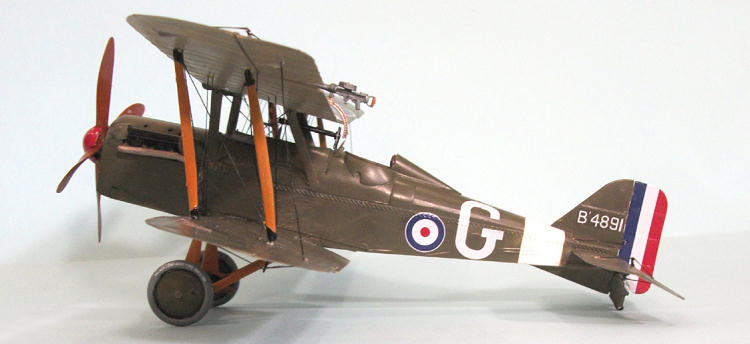
Wingnut Wings 1/32 SE.5a (Hisso)
| KIT #: | 32003 |
| PRICE: | $59.00 includes shipping |
| DECALS: | Five options |
| REVIEWER: | Tom Cleaver |
| NOTES: |

| HISTORY |
The first successful fighter designed by the great British aircraft
designer H.P. Folland, the first prototype of the Royal Aircraft Factory
Scout (Experimental) 5 flew on
Together with the Sopwith Camel, the S.E.5a was responsible for
restoring British air superiority over the Western Front following the
disaster of “Bloody April” 1917, and for maintaining that superiority for
the rest of the war.
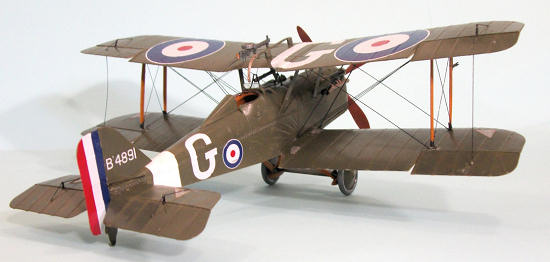 The main shortcoming of the airplane was its engine.
The original 150 h.p. Hispano-Suiza 8A V-8 provided insufficient
power for Western Front combat by May 1917 when the aircraft was introduced
by 56 Squadron.
Only 77 S.E.5s
powered by this engine were produced before the geared-drive 200 h.p. H.S.8B
engine was installed, with the airplane becoming known thereafter as the
S.E.5a.
5,265 were built by six
manufacturers:
The main shortcoming of the airplane was its engine.
The original 150 h.p. Hispano-Suiza 8A V-8 provided insufficient
power for Western Front combat by May 1917 when the aircraft was introduced
by 56 Squadron.
Only 77 S.E.5s
powered by this engine were produced before the geared-drive 200 h.p. H.S.8B
engine was installed, with the airplane becoming known thereafter as the
S.E.5a.
5,265 were built by six
manufacturers:
The dependence on the Hispano-Suiza engine and its derivative, the
Wolseley Viper, almost led to the abandonment of the airplane, due to the
engine having been rushed into production before being fully developed and
tested.
A whole host of
problems afflicted the engine, the worst of which was inadequately hardened
gears in the reduction box, which frequently led to sudden seizure and loss
of the propeller; the effect of such an unreliable engine on pilot morale
can be imagined.
There were
additional problems with the cooling system, fuel and oil pipes, carburetor,
oil pump, and crankshaft.
These
were only remedied in 1918, with the adoption of the direct-drive Wolseley
Viper as the preferred engine. Additionally, the original steel tube
undercarriage was weak and prone to collapse, leading to replacement by a
reinforced wooden landing gear.
Once the engine problems were ironed out, the S.e.5a was a dependable
and highly effective fighter that was far less dangerous to fly than the
Camel.
Using tactics that
relied on speed, high altitude performance, and its stability as a gun
platform, the aircraft became the mount of many famous Aces and was popular
with novice and experienced pilots alike.
James T.B. McCudden
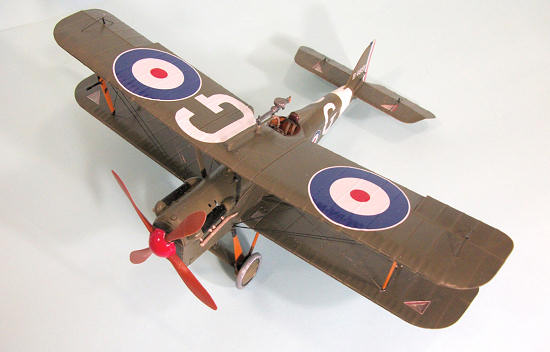 James T.B. McCudden was the most highly decorated British flyer of
the Great War, with six British and one French medal for his achievements,
including the Victoria Cross, the highest British award for valor.
With 57 victories at the time of his death in 1918, he was the
seventh-ranked ace of the Great War.
James T.B. McCudden was the most highly decorated British flyer of
the Great War, with six British and one French medal for his achievements,
including the Victoria Cross, the highest British award for valor.
With 57 victories at the time of his death in 1918, he was the
seventh-ranked ace of the Great War.
Having joined the Royal Flying Corps as an Air Mechanic in 1913 after
getting a ride in an early Farman, the working class McCudden rose through
the ranks on sheer ability to achieve the rank of Major, a feat largely
unheard-of in the class-conscious British military.
Following the outbreak of war in August 1914, McCudden went to France
as a mechanic with No. 3 Squadron, where he was allowed to fly as an
observer over the next few months.
Having volunteered for flight training, he returned to
On
In February, 1917, McCudden returned to
Assigned to Home Defense flying the Sopwith Pup with 66 Squadron,
McCudden was the only pilot of an intercepting force of 95 sent up against a
In August 1917, McCudden was assigned to 56 Squadron as a flight
commander.
The new S.E.5a was
presenting many mechanical problems.
A true “Working Class Hero,” McCudden’s mechanical expertise was
instrumental in helping to solve the engine problem through improved
maintenance.
He was a master of tactics, and a good teacher of what he learned to
the members of his flight, having scored 9 victories in his first month with
56.
McCudden’s abilities as a
tactician and aerial leader were never more on display than on
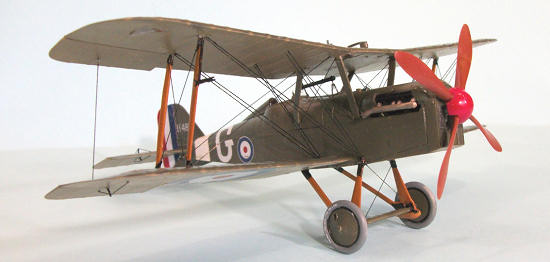 “The
Hun triplane was practically underneath our formation now, and so down we
dived at a colossal speed. I went to the right, Rhys‑Davids to the left, and
we got behind the triplane together. The German pilot saw us and turned in a
most disconcertingly quick manner, not a climbing nor Immelmann turn, but a
sort of flat half spin. By now the German triplane was in the middle of our
formation, and its handling was wonderful to behold. The pilot seemed to be
firing at all of us simultaneously, and although I got behind him a second
time, I could hardly stay there for a second. His movements were so quick
and uncertain that none of us could hold him in sight at all for any
decisive time...
“The
Hun triplane was practically underneath our formation now, and so down we
dived at a colossal speed. I went to the right, Rhys‑Davids to the left, and
we got behind the triplane together. The German pilot saw us and turned in a
most disconcertingly quick manner, not a climbing nor Immelmann turn, but a
sort of flat half spin. By now the German triplane was in the middle of our
formation, and its handling was wonderful to behold. The pilot seemed to be
firing at all of us simultaneously, and although I got behind him a second
time, I could hardly stay there for a second. His movements were so quick
and uncertain that none of us could hold him in sight at all for any
decisive time...
“As long as I live I
shall never forget my admiration for that German pilot, who single‑handed
fought seven of us for ten minutes, and also put some bullets through all of
our machines. His flying was wonderful, his courage magnificent, and in my
opinion he is the bravest German airman whom it has been my privilege to see
fight.”
Following the battle with Voss, McCudden received a new S.E.5a,
B4891, on which he used his extensive mechanical knowledge to improve the
engine, giving it special high-compression pistons and supervising a
meticulous rebuild which gave the airplane an additional 4,000 feet of
combat ceiling.
With this
advantage he began going after high-altitude reconnaissance aircraft.
Between September 1917 and his return to England in March 1918,
McCudden shot down 21 of these difficult targets, an achievement no other
Allied fighter pilot came close to, of the 32 victories scored in this
machine.
B4891 was the most
successful single S.E.5a of the war.
British policy after the death of Albert Ball had been not to
publicize the achievements of individual pilots.
This changed in December 1917, when Lord Northcliffe was placed in
charge of the Ministry of Information.
With flyers’ exploits now publicized, McCudden was awarded the
Victoria Cross in March 1918.
He was so publicity-shy that he neglected to tell his own family he had
received the award from King George V.
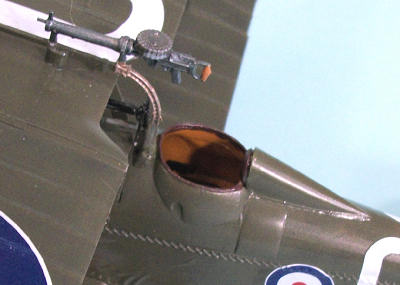 Promoted to Major upon receiving the VC, with a score of 57
victories, McCudden was given assignments in
Promoted to Major upon receiving the VC, with a score of 57
victories, McCudden was given assignments in
Finally accepted for command of 60 Squadron in July 1918, McCudden
collected a factory-new S.E.5a on July 8 and flew to
Unlike many of his fellow Empire aces (most notably “top scorer” Billy Bishop), all of McCudden’s claims have been verified from Allied and German sources. He actually may be the top scoring RFC/RNAS/RAF pilot of the Great War, and thus the top British flying ace of all time, with Raymond Collishaw his nearest competitor in fully-verified claims.
| THE KIT |
Wingnut Wings S.E.5a (Hisso) was one of the first four kits released
by the company in 2009.
The kit
comprises 132 injection-molded parts in grey plastic on four sprues, a sprue
of clear parts and a 7-part phot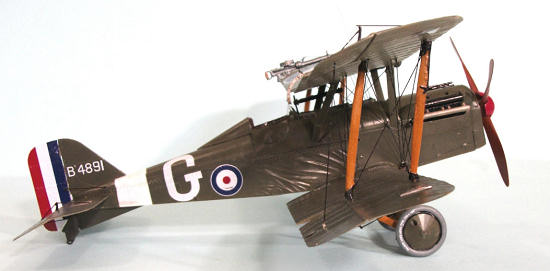 oetch
fret including the seat belts.
Cartograf decals are provided for five aircraft.
oetch
fret including the seat belts.
Cartograf decals are provided for five aircraft.
Pheon Decals also provides an excellent decal sheet, 32004, “S.E.5a
(Hispano) Aces in
True Details provides a resin set that allows a modeler to build the highly-modified B4891 with its reinforced cockpit, as well as a very nice resin figure of McCudden. Sadly, True Details gets it wrong as to which airplane used this modification, stating it should be used on B4863 and providing decals for that specific airplane. Pheon did better research, and has the markings for B4891, which differ from the earlier B4863. If a modeler wants to do the “Voss airplane,” these individual markings can be used or the markings provided on the Pheon sheet.
| CONSTRUCTION |
There are however, two “quirks” to this kit that are not specifically
dealt with in the instructions.
The first quirk involves the engine.
If you build the model per the instructions, you will have an open
engine display.
If you want to
build the model as a “curbside” without displaying the engine, as I chose to
do, you must modify the engine assembly sequence.
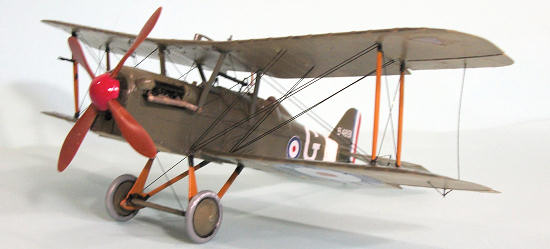 First, assemble the upper engine cowling, with the fairings fore and
aft of the cylinder heads.
Then
cut off the attachment pegs on the bottom of each cylinder head.
Then insert the cylinder heads into the upper cowling, so they fit
inside the fairings.
First, assemble the upper engine cowling, with the fairings fore and
aft of the cylinder heads.
Then
cut off the attachment pegs on the bottom of each cylinder head.
Then insert the cylinder heads into the upper cowling, so they fit
inside the fairings.
The rest of the engine should be assembled and put into position in
the forward fuselage.
Attach
the assembled radiator to the front of the fuselage.
Then attach the upper engine cowling, which will require some pushing
and shoving to get it fully into position.
The other quirk involves attachment of the upper wing.
The locating holes for the cabane struts are nice and deep.
I found that if you attach the cabane struts to the upper wing first,
rather than to the fuselage first as the instructions would have you do, you
get a much better and easier fit.
The attachment holes in the wings for the interplane struts are also
nice and deep on the lower wing.
Attach the interplane struts to the lower wing.
Then put the upper wing in position and glue the cabane struts to the
fuselage.
Follow this up by
slipping the interplane struts into the holes in the upper wing, and you
will have a nice strong fit.
If you choose to do the McCudden airplane with the True Details resin
cockpit cowling, cut it and test fit carefully. You need to thin down the
area at the rear of the cowling so it is as thin as the original plastic
part, which allows it to fit to the fuselage without any need of gap filler
other than running some cyanoacrylate glue in the joints.
I
also used the Pheon resin replacement vertical fin and rudder, which provide
rib detail missing from the kit parts.
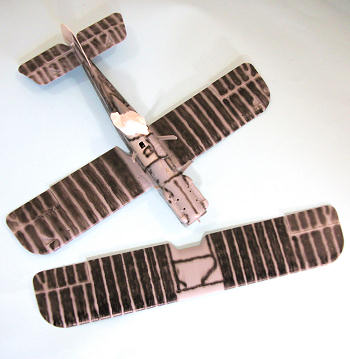 Other than that, follow the instructions.
I used the full Sutton harness from the Eduard S.E.5a detail set that
was used on some S.E.5as during the war, on the belief McCudden would have
equipped himself with the best gear for this special airplane.
I did not use the Eduard instruments, because with the built-up
cockpit sides you cannot see the instrument panel all that well.
I will save them for another S.E.5a with the standard cockpit.
Other than that, follow the instructions.
I used the full Sutton harness from the Eduard S.E.5a detail set that
was used on some S.E.5as during the war, on the belief McCudden would have
equipped himself with the best gear for this special airplane.
I did not use the Eduard instruments, because with the built-up
cockpit sides you cannot see the instrument panel all that well.
I will save them for another S.E.5a with the standard cockpit.
Once the fuselage, lower wing and tail assembly were finished and set up, it was time for painting.
| COLORS & MARKINGS |
I first “pre-shaded” the model with flat black in the areas between
the ribs, and around the folds and crimps in the fuselage fabric.
I used thinned Tamiya “Buff” for the lower
| FINAL CONSTRUCTION |
| CONCLUSIONS |
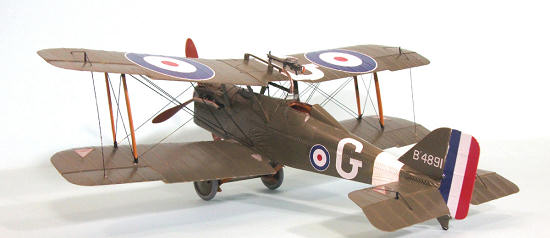
October 2011
If you would like your product reviewed fairly and quickly, please contact me or see other details in the Note to Contributors.